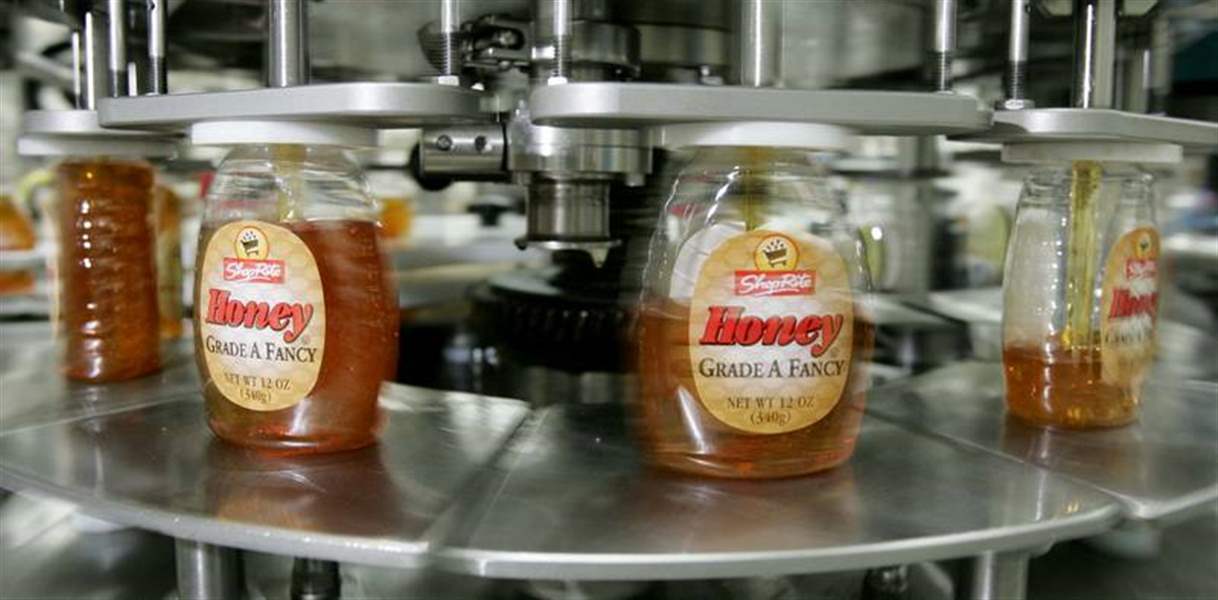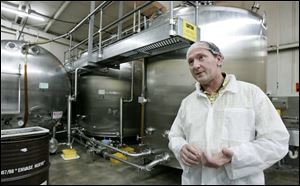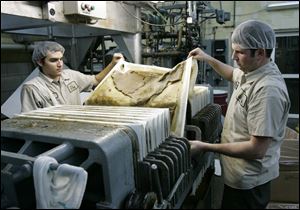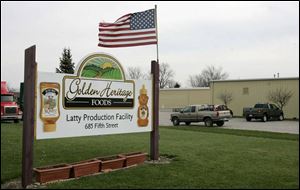
Honey's a sweet Ohio business
12/3/2006
Honey packaged by Golden Heritage accounts for an eighth of U.S. consumption.

Honey packaged by Golden Heritage accounts for an eighth of U.S. consumption.
LATTY, Ohio - Twenty years ago, honey processor Dwight Stoller took note of various changes in the way food items were made and sold.
His family's business, Stoller's Honey in Latty, was gradually changing its focus from keeping honey bees to packaging their sweet substance for wholesale.
National grocery chains were replacing many regional retailers that bought local products. The relationships between food manufacturers and retailers were becoming more formal, too.
And for Mr. Stoller, whose grandfather started beekeeping in the 1920s, there was no doubt he had to take a risk and find a partner.
"You can't waste energy grieving over the way you did things in the past," he said.
After searching for a company with a similar culture and identity, Stoller's Honey merged with a Nebraska firm twice its size nearly five years ago, bringing together two family-owned companies drenched in the honey business since the 1950s.

Behind Dwight Stoller, CEO of Golden Heritage Foods, are tanks of honey being fed to bottling line.
In forming Golden Heritage Foods LLC, a name that evokes those decades of honey processing and a promise to eventually branch into other food products, the former Stoller's Honey and Barkman Honey Co. pooled finances, expertise, two production facilities, and customers.
The result is one of the nation's top three sellers of packaged honey products, accounting for nearly 50 million pounds a year, or roughly an eighth of the nation's consumption.
The company, headquartered in Hillsboro, Kan., has 121 employees, including 41 at the Latty processing plant about 80 miles southwest of Toledo and at a newly opened warehouse in nearby Van Wert.
Mr. Stoller, chief executive, and other managers are based in Latty, where the smell of honey and flooring with a honeycomb pattern greet visitors, while Chairman Brent Barkman and others are in Hillsboro.

Tim Heiges, left, and Aaron Lipp remove fi ltering paper before bottling.
The honey is sold under its own brand name or private labels to Wal-Mart, Meijer, distributors, food companies that process meat and other products, and other businesses.
For customers in Paulding County and beyond, the biggest difference is the well-known Stoller name no longer appears on honey bottles shaped like bears and other packages.
Golden Heritage decided to stick with Stoller's containers and the Busy Bee brand name to cut costs, said Mr. Stoller, 50.
The gradual change to adopting the Busy Bee name, however, was carefully handled, said Leon Klopfenstein, owner of Blue Creek Market in nearby rural Haviland.
The store gets honey calls from across the nation, including a recent request for a case sent to Washington, he said.
"It appears to be as popular as ever," Mr. Klopfenstein said. "They appear to have a very loyal following."
Honey is used in a variety of ways as a sweetener. Some baking recipes call for honey, for example, and it also can be used to top pancakes and other dishes. Food manufacturers buy Golden Heritage honey to use in meats, salad dressings, and other products.
Golden Heritage doesn't keep bees, although family members from both sides remain involved with that traditional part of the business. Mr. Stoller's relatives at one time kept 4,000 colonies, but his father Wayne - who founded the company with his wife, Dorothy, and is now 80 - kept 150 hives as a hobby last summer.

Golden Heritage Foods LLC in Latty, Ohio, is the nation s third largest producer of honey.
Beekeeping hasn't just changed for the Stollers.
There are as many as 212,000 beekeepers nationwide, but the vast majority have less than 25 hives, according to the National Honey Board.
U.S. honey production has been unable to hit its usual annual 200 million pound mark for the last five years, while demand is at 400 million pounds, Mr. Stoller said. North Dakota, California, South Dakota, Florida, and Minnesota are the leading honey producing states, accounting for nearly 104 million pounds last year, according to the board.
The number of beekeepers has declined as increased fuel costs, competition from imported honey, the 2002 drought, and mites and other pests have affected production, said Bruce Boynton, chief executive of the honey trade group.
"It's been very hard for people to stay in business," he said.
Some beekeepers have found it makes better business sense for them to offer pollination services to California almond growers with their bees than to produce honey, Mr. Boynton said.
Still, American demand for honey has grown strong, Mr. Boynton said. Pure honey has no additives and so is viewed by many as a healthy sweetener, and it is being used in more beauty products, he said.
Much of what is processed in Latty comes from the United States, Canada, and Argentina, with some honey coming from other South American, European, and Far Eastern countries, Mr. Stoller said. Honey arrives at the facility for processing in 55-gallon barrels, and it is heated, filtered, cooled, and bottled.
"The actual process is very simple," Mr. Stoller said. "There's not much that happens."
Blending honey that ranges in color and flavor from the light yellow of mild clover honey to the dark brown of stronger wildflower honey is much more complex, the firm's CEO said. Tests are done before Golden Heritage buys honey, so the company knows it is pure and meets color and other criteria, he said.
The Latty facility produces 15 honey blends, packaging them in at least 20 different container combinations, Mr. Stoller said.
"There's a science and kind of an art to creating a product the customer wants," he said. "We have to source and blend correctly."
Contact Julie M. McKinnon at: jmckinnon@theblade.com or 419-724-6087.